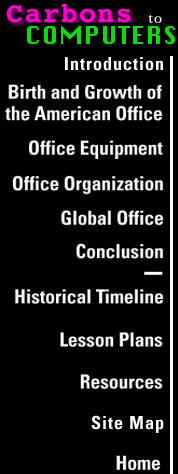
Conclusion
There was a time when the American office could be defined as simply a building that housed bosses and workers for eight hours, five days a week. Offices were often defined by what was being produced, rather than who was doing the producing and how. The postindustrial age shifted the workplace's emphasis from production and marketing of goods to information management. In particular, offices of the 1980s abandoned functionality and demonstrated excesses in the corporate "lifestyle"--where a glossy image superseded process and more was better.
Perhaps as a result of the free-spending 1980s, offices nationwide have now begun to streamline, or downsize, operations in order to remain competitive in the crowded global marketplace. Thus, the American workplace has entered the information age as a leaner and more efficient space in which to manage the vast quantities of information demanded by the global economy.
Office technology has driven much of the innovation in communications, working styles, and even in the value placed on certain skill sets. Geography is no longer a barrier to doing business; nor are business travelers cut off from the communications infrastructure that supports their work.
Function has now given meaning to form, as teamwork has replaced the traditional hierarchical corporate structure and physical boundaries no longer exist between workers and their managers. Yet ironically, corporate America's embrace of technologies such as e mail and voice mail belies the notion that colleagues should have more contact with each other and with their customers.
It is difficult to predict the office landscape of the 21st century. Trends point to smaller and faster office machines that will be capable of carrying out more complex functions with minimal human input. Geographical boundaries will likely shrink to the point that place and time become irrelevant in the business community. Fewer workers may eventually staff even smaller workspaces. Perhaps many of those displaced will find that commuting "to the office" is not the most productive use of their time, and opt instead for working at home...returning to the work patterns of days once considered long gone.